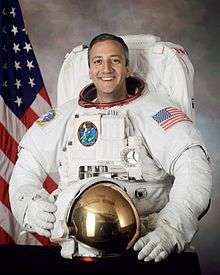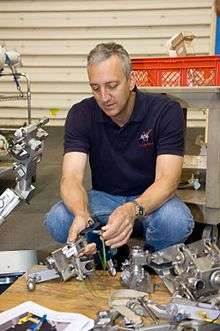Michael J. Massimino
| Michael J. Massimino | |
|---|---|
 | |
| NASA Astronaut | |
| Nationality | American |
| Status | Retired |
| Born |
Michael James Massimino August 19, 1962 Oceanside, New York, U.S. |
Other occupation | Engineer |
|
Columbia University, B.S. 1984 Massachusetts Institute of Technology, M.S. 1988, D.M.E. 1990, Ph.D. 1992 | |
Time in space | 23d 19h 48m |
| Selection | 1996 NASA Group 16 |
| Missions | STS-109, STS-125 |
Mission insignia |
|
Michael James "Mike" Massimino (born August 19, 1962) is an American engineer and former NASA astronaut who is now a professor of mechanical engineering at Columbia University and the senior advisor of space programs at the Intrepid Sea, Air & Space Museum.[1] Massimino is a veteran of two Space Shuttle missions, both of which serviced the Hubble Space Telescope (HST), including the historic final repair mission.
Early life
Massimino was born August 19, 1962 in Oceanside, New York. His hometown is Franklin Square, New York. Massimino graduated from H. Frank Carey Junior-Senior High School in Franklin Square, New York in 1980. He went on to attend Columbia University, graduating with a Bachelor of Science degree in Industrial Engineering in 1984. He then attended the Massachusetts Institute of Technology, graduating with a Master of Science degree in Mechanical Engineering and a Master of Science degree in Technology and Public Policy in 1988.[2] He continued his education at MIT, earning a Degree of Mechanical Engineer in 1990 and a Doctor of Philosophy degree in Mechanical Engineering in 1992.[2][3]
Career
Upon completing his B.S. degree from Columbia, Massimino worked for IBM as a systems engineer in New York City from 1984 until 1986. In 1986 he entered graduate school at the Massachusetts Institute of Technology where he conducted research on human operator control of space robotics systems in the MIT Mechanical Engineering Department's Human-machine systems Laboratory. His work resulted in the awarding of two patents. While a student at MIT he worked during the summer of 1987 as a general engineer at NASA Headquarters in the Office of Aeronautics and Space Technology, during the summers of 1988 and 1989 as a research fellow in the Man-Systems Integration Branch at the NASA Marshall Space Flight Center, and during the summer of 1990 as a visiting research engineer at the German Aerospace Center (DLR) in Oberpfaffenhofen, Germany. After graduating from MIT in 1992, Massimino worked at McDonnell Douglas Aerospace in Houston, Texas as a research engineer where he developed laptop computer displays to assist operators of the Space Shuttle remote manipulator system. These displays included the Manipulator Position Display, which was evaluated on STS-69. From 1992 to 1995 he was also an adjunct assistant professor in the Mechanical Engineering & Material Sciences Department at Rice University, where he taught feedback control of mechanical systems. In September 1995, Massimino joined the faculty of the Georgia Institute of Technology as an assistant professor in the School of Industrial and Systems Engineering. At Georgia Tech he taught human-machine systems engineering classes and conducted research on human-machine interfaces for space and aircraft systems in the Center for Human-Machine Systems Research, and is currently an Adjunct Assistant Professor at Georgia Tech. He has published papers in technical journals and in the proceedings of technical conferences. In 2011, Massimino co-hosted season three of National Geographic Channel's Known Universe documentary series along with Sigrid Close, Andy Howell, David E. Kaplan, and Steve Jacobs.[2]
NASA career

Selected as an astronaut candidate by NASA in May 1996, Massimino reported to the Johnson Space Center in August 1996. He completed two years of initial training and evaluation and qualified for flight assignment as a mission specialist. Prior to his first space flight assignment, Massimino served in the Astronaut Office Robotics Branch, and in the Astronaut Office Extravehicular Activity (EVA) Branch. He has served as a CAPCOM (spacecraft communicator) in Mission Control and performed other technical tasks in the Astronaut Office CAPCOM Branch. Currently he is on loan from the Johnson Space Center and serves as a visiting professor at Columbia University teaching a course on human spaceflight.
On July 29, 2014, Massimino announced that he would be leaving NASA to pursue a teaching career at Columbia University, in New York City.[2]
Spaceflight experience
STS-109 Columbia (March 1–12, 2002). STS-109 was the fourth Hubble Space Telescope (HST) servicing mission. The crew of STS-109 successfully upgraded the Hubble Space Telescope leaving it with a new power unit, a new camera (the Advanced Camera for Surveys), and new solar arrays. STS-109 set a record for spacewalk time with 35 hours and 55 minutes during 5 spacewalks. Massimino performed two spacewalks totaling 14 hours and 46 minutes. STS-109 orbited the Earth 165 times, and covered 4.5 million statute miles in over 262 hours and 10 minutes.[2]
STS-125 Atlantis (May 11–24, 2009) was the final Hubble servicing mission by the Space Shuttle. Atlantis landed in California after stormy weather prevented the shuttle from landing at NASA's home base in Florida as previously planned. During the mission Massimino became the first person to use Twitter in space.[4] Rather than using the service directly while on-orbit, however, Massimino composed his messages and shared them with Mission Control which then posted the messages via the Internet to Twitter.[5] Massimino's public updates about his training for the STS-125 mission began April 3, 2009[6] and he remains active on the service as of July 2011.[7]
In media
Massimino's book Spaceman: An Astronaut's Unlikely Journey to Unlock the Secrets of the Universe was published by Crown Archetype on October 4, 2016. The Audible e-book version is narrated by Massimino.
Massimino makes a brief appearance at a shuttle launch in Chapter XXIX of the 2012 novel A Hologram for the King, in which he discusses his experience in space.
Massimino appeared as himself in a recurring role on the CBS TV sitcom The Big Bang Theory launching aboard a Russian Soyuz to the International Space Station.
Massimino made a guest appearance in one of the video lectures of An Introduction to Interactive Programming in Python, a MOOC offered by Rice University. Massimino has a son and daughter.[8]
Massimino appeared in a 2015 MasterCard Rewards commercial.
In the PBS children's program Sid the Science Kid, Michael Massimino appeared as himself in an episode focused on scientists.
He is a frequent guest on Neil deGrasse Tyson's podcast StarTalk, and has also appeared on the TV version.
Organizations
- MIT Alumni Association
- Columbia University Alumni Association
- Association of Space Explorers.
Awards and honors
- NASA Space Flight Medals
- NASA Graduate Student Researchers Program Fellowship
Personal life
He enjoys baseball, family activities, camping, and coaching kids' sports.[2]
Filmography
| Year | Title | Role | Notes |
|---|---|---|---|
| 2011 | Sid the Science Kid | Himself | "I Want to Be a Scientist!" (episode 57) |
| 2011–14 | The Big Bang Theory | Himself | "The Friendship Contraction" "The Countdown Reflection" "The Decoupling Fluctuation" "The Re-Entry Minimization" "The Table Polarization" "The First Pitch Insufficiency" |
| 2015 | StarTalk | Himself | "Chris Hadfield" (episode 7)[9] "Bas Lansdorp" (Mars One) (episode 17)[10] |
References
![]() This article incorporates public domain material from websites or documents of the National Aeronautics and Space Administration.
This article incorporates public domain material from websites or documents of the National Aeronautics and Space Administration.
- ↑ http://www.intrepidmuseum.org/LatestNews/October-2014/The-Intrepid-Museum-Appoints-Former-NASA-Astronaut.aspx
- 1 2 3 4 5 6 "Astronaut Bio: Michael J. Massimino". National Aeronautics and Space Administration. Retrieved September 29, 2016..
- ↑ Massimino, Michael J. (1992). "Sensory Substitution for Force Feedback in Space Teleoperation (Ph.D. Thesis)". Massachusetts Institute of Technology. Retrieved July 5, 2012.
- ↑ Hubble astronaut sends first ever Twitter message from space to say he is 'enjoying the view'
- ↑ Horowitz, Etan (May 22, 2009). "The great debate over Astro Mike's 'tweets from space'". The Orlando Sentinel. Archived from the original on May 25, 2009. Retrieved October 2, 2009.
- ↑ Massimino, Mike (2009-04-03). "Astro_Mike". Twitter. Retrieved 2009-05-28.
- ↑ "October 19, 2009 tweet". Twitter. 2009-10-19. Retrieved 2009-10-20.
- ↑ http://www.startalkradio.net/tag/mike-massimino/
- ↑ http://channel.nationalgeographic.com/startalk/episodes/chris-hadfield/
- ↑ http://channel.nationalgeographic.com/startalk/episodes/mars-1/
External links
- Mike Massimino on Twitter

- (http://www.mikemassimino.com)
- NASA biography
- Spacefacts biography of Michael J. Massimino
- Michael J. Massimino at the Internet Movie Database
- Interview with Mike Massimino about accuracy of movie Gravity